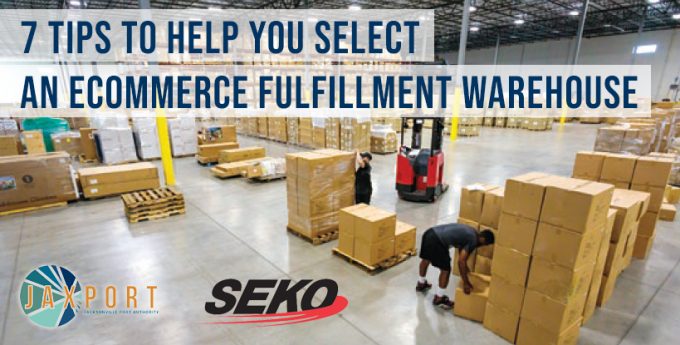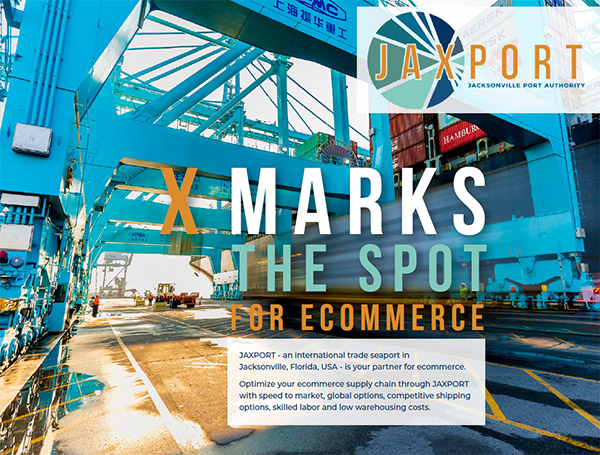7 tips to help you select an ecommerce fulfillment warehouse
- Home
- >
- Cargo Blog
- >
- 7 tips to help you select an ecommerce fulfillment warehouse


By Alexandra Gonzalez, Business Development Manager, SEKO Logistics Jacksonville
Warehousing and shipping are critical components for any ecommerce business, and working with an efficient warehousing operator can help you achieve a seamless and efficient supply network. Consumers now demand same-day and next-day shipping, and this is exerting immense pressure on ecommerce retailers, shipping companies and distribution facilities to ensure fast, effective shipping.
Joao Rios, Managing Director of SEKO Logistics Jacksonville, a 34,000 square feet warehouse facility, says combining efficient operations with a trusted partner is a good strategy for shippers to improve their logistics. “At SEKO Logistics, we leverage our decades of experience and client-centric approach to develop efficiencies and optimize shippers’ supply chains,” he said.
The SEKO Logistics team has assembled seven tips to help shippers choose an ecommerce fulfillment warehouse:
1. Choose a location close to your customers

Your ecommerce warehouse should be in a convenient location close to your customers to ensure cost-effective and timely deliveries. By utilizing warehouses in ideal locations, you can minimize costs and delivery times to have your products shipped to your customers.
“Our new facility in Jacksonville is ideal for companies moving freight throughout the Southeast U.S,” said Rios, citing Jacksonville’s reach to more than 98 million consumers within a day’s drive.
2. Select a warehouse with superior access
Your warehouse should be easily accessible by multiple modes of transportation. “As an example of accessibility, our Jacksonville facility is located two miles from Jacksonville International Airport, and it’s a 15-minute drive from JAXPORT’s northside terminals, making it easy to import or export goods by air or sea,” said SEKO Logistics Managing Director and Partner Wenzel Lewinsky.
In addition to transport access, ensure your warehouse is compatible with the specific prerequisites of the goods you’re shipping.
3. Take advantage of multifaceted capabilities
An asset-based warehouse provides improved storage services, cost efficiency and operations over a warehouse with a traditional layout, Lewinsky said. Asset-based providers generally are equipped with transportation services and employees who can provide a higher level of customer service, allowing for efficient storage and handling for a variety of freight. For example, Lewinsky said, our Jacksonville facility is capable of handling medical goods, high tech products, seasonal retail, telecommunications items, industrial goods, durable goods, overstock and more.
4. Embrace technology
When assessing warehouse vendors, inquire about their warehouse management system. Ensure the warehousing company’s processing and supply chain systems can be integrated with your delivery companies and related supply chain services. Warehouses that offer advanced technology like electronic data exchange, pick-by-vision systems, or drones can provide smooth warehousing operations.
“At SEKO Logistics, we integrate with a variety of ecommerce systems, including those offered by Amazon SQS, Cargowise, Magento, Patchworks, Shopify and Woocommerce,” said Rios. SEKO also uses artificial intelligence to exchange and process data so shippers can benefit from the most advanced technical support, he added.
[clickToTweet tweet=”Combining efficient operations with a trusted partner is a good strategy for shippers to improve their logistics. -Joao Rios, @SEKO_Logistics” quote=”Combining efficient operations with a trusted partner is a good strategy for shippers to improve their logistics. -Joao Rios, @SEKO_Logistics”]5. Go with experience
When evaluating warehousing vendors, research the experience of your prospective service provider. Check operational dates or the establishment date – this will provide you with insight into its experience and aptitude in the sector. Ensure whether the warehouse is experienced in handling products from your industry. For example, if you’re in the business of selling food products, pick a warehouse with expertise in the food warehousing business.
6. Assess the workforce
Employees play a vital role in the storage and handling of goods in a warehouse. Therefore, a warehousing service provider with a reliable and experienced team with the necessary skills will be a force multiplier to your operation. Also consider the number of employees – is it compatible with the size of the warehouse? Inquire as to the manpower utilization – how much of the inventory is handled per person per day? Optimizing metrics like these, with specific applicability to your product, will make your handling and shipping experience more efficient.
7. Secure additional benefits from value-add services
Besides providing standard services like handling, storage, and shipping, when you choose a provider who offers additional services like labeling, packaging, quality control, dispatching, and reverse logistics, that will save your ecommerce business time and money in the long term.
About SEKO Logistics
With over 120 offices in 40 countries worldwide, SEKO Logistics provides complete supply chain solutions, specializing in transportation, logistics, forwarding and warehousing. For more information about the Jacksonville facility, call +1 904-512-6406 or email jax.operations@sekologistics.com.

From startups to large retailers, more and more businesses are choosing JAXPORT to optimize their ecommerce supply chains.
In this 18-page e-book from JAXPORT, learn how Northeast Florida is meeting the industry’s growing demand for industrial real estate space in close proximity to urban population centers.
